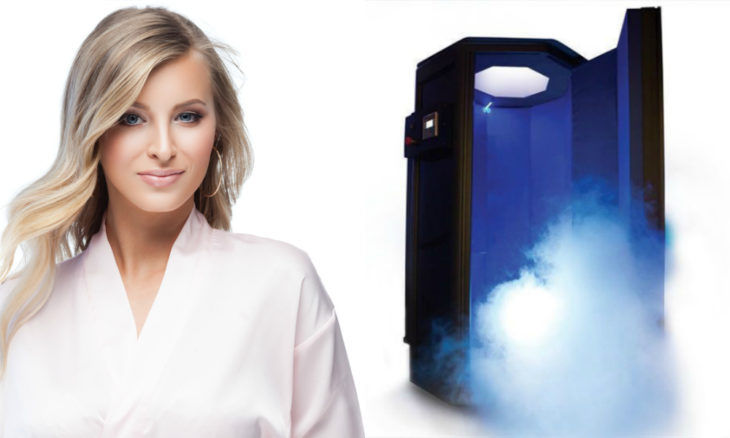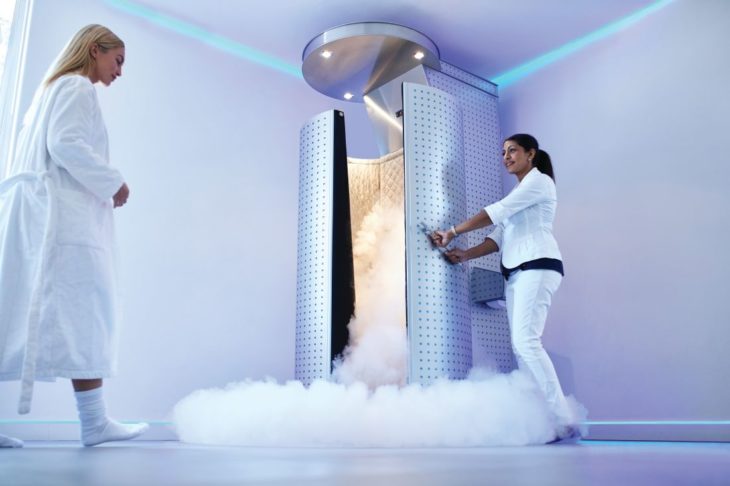When we slam into something or get injured by accident, we all put on ice to relieve the inflammation because it is one of the remedies that work best. So what if we could apply this same technique to the whole body to treat other health issues? This is what modern cold therapies do by enhancing the effects of the application of cold as a medical and cosmetic treatment.
Low temperatures, as a therapy, have many advantages. There are two ways to use cold for medical or aesthetic purposes: cryotherapy, which applies low temperatures directly on the skin by shooting or pulverizing frozen gas to provoke contraction, with an anesthetic or anti-inflammatory effect; and cryolipolysis which helps to lower measures.

Source: Shreveport Cryotherapy
Contents
What is whole body cryotherapy?
Cryotherapy consists in the exposure of the body surface to very low temperatures (between -110º to -196ºC). As the mechanisms of regulation of our body prevent the body temperature from falling from 36.5 ºC very quickly, during that short period of time in which the body resists the cold, a series of reactions with very beneficial effects are set in motion. According to CryosenseUSA, a full-body cryotherapy session lasts from 2 to 4 minutes.
The body tries to compensate for this cold by producing heat, and it does so by generating energy at the cost of burning localized fat deposits and accelerating metabolism. This effect eliminates the accumulations of fat, causing a loss of weight and volume. In addition, it acts on the muscles and tissues, which are toned to produce heat, exercising, and avoiding flaccidity in the skin. The intense cold also produces a narrowing of the blood vessels followed by vasodilation when the cold is removed. Thus, cryotherapy achieves a series of chemical reactions within our bodies that favor cellular nutrition, as well as an increase and an improvement in blood circulation. These are some of its benefits:
- It makes the heart muscle work by increasing its volume -but not the heart rate.
- It favors the action of insulin, improving the levels of simple sugar in the blood. In addition, it increases the correct secretion of pancreatic enzymes, such as insulin, or hepatic enzymes, such as transaminases.
- It helps the circulation of gastric substances improving digestion, as well as the evacuation of stool at the level of the large intestine. It also improves the intestinal musculature.
- It promotes the absorption of food substances in the small intestine
- It favors the elimination of toxic substances accumulated in the soft tissues such as muscles, tendons, or joints.
Due to its numerous benefits, cryotherapy can have diverse applications both in the world of sport and in the world of beauty treatments:
Cryotherapy for athletes
Cryotherapy is indicated for many people, although perhaps one of its best know applications is in the world of sports medicine. It is not strange to watch soccer players getting into cryotherapy cabins after practice or while they are recovering from an injury. This is so because cryotherapy is indicated for fibrillary microorrhotures, tendinitis, tendinosis, muscle overloads, etcetera.
In addition, the fact that it improves the heart muscle, blood circulation or the elimination of harmful substances allows the athlete to increase their marks and optimize their effort both in training and in competitions.
In the case of sportsmen and women, cryotherapy is also very useful after an intense exercise session, since, in addition to promoting muscle recovery, it mitigates blows and stiffness.

Source: MDedge
Cryotherapy as an aesthetic treatment
As a beauty treatment, cryotherapy has almost immediate effects on the skin and hair, by eliminating by this means the vast majority of toxins in the body, so it is indicated to treat dermal alterations such as psoriasis, atopic dermatitis, eczemas, certain skin, cellulite …
Plus, after a minute and a half of application, the patient stops burning simple sugar and begins to burn fat, so it is also effective for slimming. However, it is important not to confuse cryotherapy with cryo lipolysis, a non-invasive aesthetic treatment that helps eliminate fat by external application of cold through a plate that cools the fat cells and facilitates their decomposition and subsequent elimination.
Contraindications of cryotherapy
However, cryotherapy also has contraindications: not everyone can try it. Physiotherapists and cryotherapy experts explain that this technique is essentially a metabolism accelerator, so all those people who suffer from pathologies in which the organism (either due to congenital or secondary causes) is not able to maintain the vascular compensation mechanisms should not carry out this sanitary technique.
Therefore, patients who have suffered a myocardial infarction, any serious or severe vascular pathology, who have a history of thromboembolism or who suffer from Raynaud’s syndrome (allergy to cold) are ruled out for cryotherapy. Also, pregnant women should not undergo cryotherapy.
